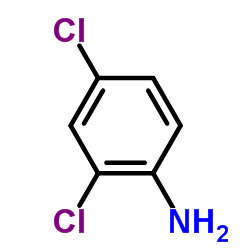2,4-Dichloroaniline

2,4-Dichloroaniline structure
|
Common Name | 2,4-Dichloroaniline | ||
|---|---|---|---|---|
| CAS Number | 554-00-7 | Molecular Weight | 162.017 | |
| Density | 1.4±0.1 g/cm3 | Boiling Point | 242.1±20.0 °C at 760 mmHg | |
| Molecular Formula | C6H5Cl2N | Melting Point | 59-62 °C(lit.) | |
| MSDS | Chinese USA | Flash Point | 100.2±21.8 °C | |
| Symbol |



GHS06, GHS08, GHS09 |
Signal Word | Danger | |
|
Biodegradation of 2-chloroaniline, 3-chloroaniline, and 4-chloroaniline by a novel strain Delftia tsuruhatensis H1.
J. Hazard. Mater. 179(1-3) , 875-82, (2010) A new strain Delftia tsuruhatensis H1 able to degrade several chloroanilines (CAs) as individual compounds or a mixture was isolated from a CA-degrading mixed bacterial culture. The isolated strain could completely degrade 3-CA and 4-CA as growth substrates, ... |
|
|
Sensitivity of muscle satellite cells to pollutants: an in vitro and in vivo comparative approach.
Aquat. Toxicol. 53(3-4) , 247-63, (2001) Muscle satellite cells from rainbow trout were exposed in vitro to increasing concentrations of different xenobiotics: copper, dichloroaniline, prochloraz, nonyl-phenol polyethexylate. Mortality and proliferation rate were measured by Hoechst binding and BrdU... |
|
|
Expression of delayed cell death (DCD) in the progeny of fish cells surviving 2,4-dichloroaniline (2,4-DCA) exposure.
Aquat. Toxicol. 63(3) , 207-19, (2003) Interest in and concern for the quality of the environment has prompted a great deal of research into methods of measuring and assessing changes in it. One problem of major interest is that of increasing amounts of mutagenic/carcinogenic chemicals generated a... |
|
|
Uptake and metabolic fate of [14C]-2,4-dichlorophenol and [14C]-2,4-dichloroaniline in wheat (Triticum aestivum) and soybean (Glycine max).
J. Agric. Food Chem. 51(16) , 4712-8, (2003) The uptake and metabolism of [14C]-2,4-dichlorophenol (DCP) and [14C]-2,4-dichloroaniline (DCA) were investigated in wheat and soybean. Seeds were exposed to a nutrient solution containing 50 microM of one of two radiolabeled compounds, and plant organs were ... |
|
|
In vitro effect of various xenobiotics on trout gill cell volume regulation after hypotonic shock.
Aquat. Toxicol. 53(3-4) , 201-14, (2001) Their functions and localisation can expose gill cells to volume changes. To maintain their vital functions, these gill cells must regulate their own volume after cellular swelling or shrinkage. Recently, we showed that rainbow trout pavement gill cells in pr... |
|
|
3,4-Dichloroaniline is detoxified and exported via different pathways in Arabidopsis and soybean.
Phytochemistry 63(6) , 653-61, (2003) The metabolic fate of [UL-14C]-3,4-dichloroaniline (DCA) was investigated in Arabidopsis root cultures and soybean plants over a 48 h period following treatment via the root media. DCA was rapidly taken up by both species and metabolised, predominantly to N-m... |
|
|
Phototransformation of 2,4-dichloroaniline in a surface freshwater environment: effects on microbial assemblages.
Bull. Environ. Contam. Toxicol. 60(1) , 81-7, (1998)
|
|
|
Biodegradability of chlorinated anilines in waters.
Biomed. Environ. Sci. 20(2) , 141-5, (2007) To identify the bacteria tolerating chlorinated anilines and to study the biodegradability of o-chloroaniline and its coexistent compounds.Microbial community of complex bacteria was identified by plate culture observation techniques and Gram stain method. Ba... |
|
|
Development of a 7-day Daphnia magna growth test using image analysis.
Bull. Environ. Contam. Toxicol. 61(3) , 355-62, (1998)
|
|
|
Cellular approaches for diagnostic effects assessment in ecotoxicology: introductory remarks to an EU-funded project.
Aquat. Toxicol. 53(3-4) , 153-8, (2001)
|